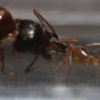I have noticed in my Camponotus colonies they have slowed growth down to a crawl and don't seem to be as active. Same for my Formica Colonies. I assume they will start hibernation next month sometime.
Time to order my wine cooler, and get ready.
When hibernation the only thing to worry about is hydration and temperature correct? Test tube colonies are fine as they are? I don't want a repeat of last year. I'm going to try for a 4 month hibernation, hopefully end of September to first of February.
The plan is to slowly bring them down to 8-10℃, over the period of a few weeks.
Far as brood just the larvae can survive hibernation correct?
Anything special I need to know to have a successful hibernation?
Edited by AntsMAN, August 29 2016 - 6:31 AM.



















